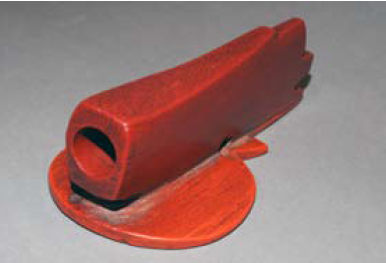|
An Ultra Rare Disc Pipe Surfaces |
by Steven R. Cooper, |
| Central States Archaeological Societies 2019
January Journal |
Kingston Springs, Tennessee |
|
This is an excerpt from "An Ultra Rare
Disc Pipe Surfaces".
Read the complete 3 page column in the Central
States Archaeological Societies 2019
January Journal which can be purchased on-line after March 2020
|
|
|
The top face of the Ceremonial or War-Bundle Disc
Pipe found in Lee County, Iowa. It measures 4 5/16 inches in
length (110mm), 2 ¼ inches in width (57mm) and 1 9/16 inches in
in height (38mm). It is made from a beautiful deep red catlinite
that has been heavily patinated from a long period of use.
Collection of the Author
|
When the Old World discovered the New
World, included amongst the many new discoveries was
the custom of smoking plants through pipes. While there
is some minor evidence of a few individuals smoking
hemp and inhaling such herbs as lavender for medicinal
purposes in European prehistory, pipe smoking was virtually
nonexistent. Of the four main plants introduced
to the Old World (potatoes, maize, tomatoes, and tobacco),
only tobacco spread to nearly every corner of the
world. In a short time, large tobacco plantations were
producing huge quantities that were transported across
the ocean into the markets of Europe and beyond. Clay
pipes were mass produced and smoking beyond a popular
pastime. Tobacco was also chewed and utilized as
snuff (the original tobacco was much stronger than that
which is smoked today). This lust for tobacco fueled the
slave trade, with massive amounts of labor required to
make these pre-industrial operations viable.
While smoking has been popular in the Old
World since the mid-1500s, the New World had a smoking
culture for thousands of years that combined pleasure,
religion and medicine into a myriad of uses that
utilized thousands of pipes. In North America the pipe
evolved from simple tubes to elaborate enhanced designs
that are truly remarkable in their form. Some were
made to be utilized in shared communal events. Many
were very small versions for personal smoking. These
forms spread throughout the continent. The Midwest
saw the development of many pipes into an art form,
with a high degree of sophistication in style and manufacture.
Read the complete column in the Central States Archaeological Societies 2019
January Journal which can be purchased on-line after March 2020

|
The pipe as viewed from the bottom. Note the curved
base that is also engraved. |
| |
| Read the complete column in the Central States Archaeological
Societies 2019 January Journal which
can be purchased on-line after March 2020 |
|
|




